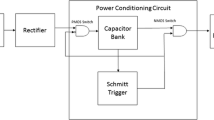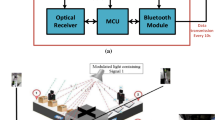Abstract
This paper describes the design of an energy and power manager for energy-harvesting devices consisting of four power converters operating in PFM mode for a low-energy and load current. The harvested energy can be maximized using a maximum power point tracking technique by a battery-charging converter, and stable voltages are generated and supplied to the charger and output loads by the other converters. These converters are optimized for high conversion efficiency with optimal switch sizes and an inductor peak current based on a numerical approach. For a further increase at a light load, the power management reduces the average bias current dynamically. It also controls the consumed or output power according to the operating condition. Using an IC fabricated in a 0.18 μm process, we verified experimentally that the energy and power manager achieves high efficiency through an optimal design with a numerical approach, and through the power management, especially for a light load, and is therefore efficient for low-energy harvesting.










Similar content being viewed by others
References
Mousazadeh, H., Keyhani, A., Javadi, A., et al. (2009). A review of principle and sun-tracking methods for maximizing solar systems output. Renewable and Sustainable Energy Reviews, 13(8), 1800–1818.
Esram, T., & Chapman, P. L. (2007). Comparison of photovoltaic array maximum power point tracking techniques. IEEE Transactions on Energy Conversion, 22(2), 439–449.
Abdelsalam, A. K., Massoud, A. M., Ahmed, S., & Enjeti, P. N. (2011). High-performance adaptive perturb and observe MPPT technique for photovoltaic-based microgrids. IEEE Transactions on Power Electronics, 26(4), 1010–1021.
López-Lapeña, O., Penella, M. T., & Gasulla, M. (2010). A new MPPT method for low-power solar energy harvesting. IEEE Transactions Industrial Electronics, 57(9), 3129–3138.
Kong, N., & Ha, D. S. (2012). Low-power design of a self-powered piezoelectric energy harvesting system with maximum power point tracking. IEEE Transactions on Power Electronics, 27(5), 2298–2308.
Kim, R., Lai, J., York, B., et al. (2009). Analysis and design of maximum power point tracking scheme for thermoelectric battery energy storage system. IEEE Transactions Industrial Electronics, 56(9), 3709–3716.
Tabesh, A., & Fréchette, L. G. (2010). A low-power stand-alone adaptive circuit for harvesting energy from a piezoelectric micropower generator. IEEE Transactions on Industrial Electronics, 57(3), 840–849.
Doms, I, Merken, P., Mertens R. P., et al. (2008). Capacitive power-management circuit for micropower thermoelectric generators with a 2.1 μW controller: Proceedings ISSCC, 300.
Dwari, S., & Parsa, L. (2010). An efficient AC–DC step-up converter for low-voltage energy harvesting. IEEE Transactions on Power Electronics, 25(8), 2188–2199.
Lefeuvre, E., Audigier, D., Richard, C., et al. (2007). Buck-boost converter for sensorless power optimization of piezoelectric energy harvester. IEEE Transactions on Power Electronics, 22(5), 2018–2025.
Dolgov, A., Zane, R., & Popovic, Z. (2010). Power management system for online low power rf energy harvesting optimization. IEEE Transactions on Circuits and Systems I, 57(7), 1802–1811.
Carlson, E. J., Strunz, K., & Otis, B. P. (2010). A 20 mV input boost converterwith efficient digital control for thermoelectric energy harvesting. IEEE Journal of Solid-State Circuits, 45(4), 741–750.
Liou, W., Yeh, M., & Lung Kuo, Y. (2008). A high efficiency dual-mode buck converter IC for portable applications. IEEE Transactions on Power Electronics, 23(2), 667–677.
Sudevalayam, S., & Kulkarni, P. (2011). Energy harvesting sensor nodes: Survey and implications. IEEE Communications Surveys & Tutorials, 13(3), 443–461.
Qiu, Y., Liempd, C.V., Veld, B.O, et al., (2011). 5 μW-to-10 mW input power range inductive boost converter for indoor photovoltaic energy harvesting with integrated maximum power point tracking algorithm: Proceedings. ISSCC, 118.
Bandyopadhyay, S., & Chandrakasan, A. P. (2012). Platform architecture for solar, thermal, and vibration energy combining with MPPT and single inductor. IEEE Journal of Solid-State Circuits, 47(9), 2199–2215.
Pakzad, S., Fenves, G., Kim, S., & Culler, D. (2008). Design and implementation of scalable wireless sensor network for structural monitoring. Journal of Infrastructure Systems, 14(1), 89–101.
Angkititrakul, s., Hu, H., (2008). Design and analysis of buck converter with pulse-skipping modulation: Proceedings PESC, 1151.
MAX1744, Switching regulator, maxim integrated, http://www.maximintegrated.com/.
Kong, N., Ha, D. S., Erturk, A., & Inman, D. J. (2010). Resistive impedance matching circuit for piezoelectric energy harvesting. Journal of Intelligent Material Systems and Structures, 21(13), 1293–1302.
Zhao, Z., Lee, W. C., Shin, Y., & Song, K.-B. (2013). An optimal power scheduling method applied in home energy management system based on demand response. ETRI Journal, 35(4), 677–686.
Acknowledgments
This research was supported by the IT R&D program of MKE/KEIT, Republic of Korea. [KI002077, EPMIC Based on Self-Chargeable Power Supply Module, and 10035171, Development of High Voltage/Current Power Module and ESD for BLDC Motor].
Author information
Authors and Affiliations
Corresponding author
Rights and permissions
About this article
Cite this article
Heo, S., Lee, Sk. & Yang, Y.S. An efficient energy and power manager for autonomous systems based on energy harvesting. Analog Integr Circ Sig Process 81, 299–311 (2014). https://doi.org/10.1007/s10470-014-0386-x
Received:
Revised:
Accepted:
Published:
Issue Date:
DOI: https://doi.org/10.1007/s10470-014-0386-x




